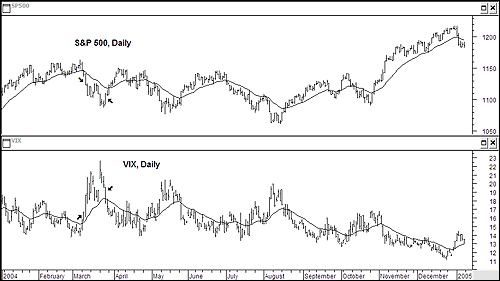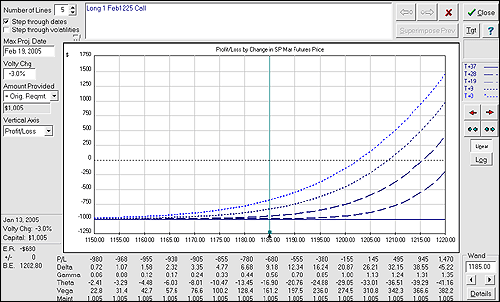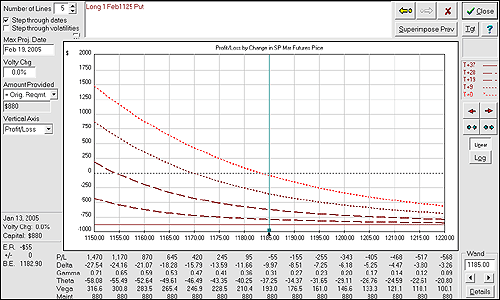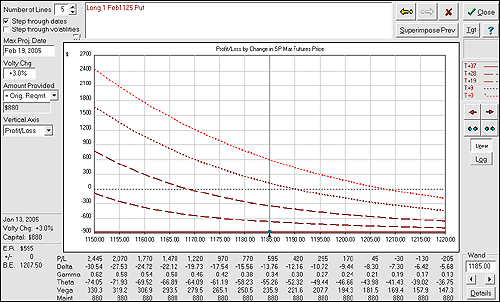|
|
Whether you are planning to purchase a put or call option, it pays to know more than just the impact of a move of the underlying on your option's price. Often option prices seem to have a life of their own even when markets move as anticipated. A closer look, however, reveals that a change in implied volatility is usually the culprit.
While knowing the effect volatility has on option price behavior can help cushion against losses, it can also add a nice bonus to trades that are winning. The trick is to understand the price-volatility dynamic, the historical relationship between directional changes of the underlying and directional changes in volatility. Fortunately, this relationship in equity markets is easy to understand and quite reliable.
The Price-Volatility Relationship
A price chart of the S&P 500 and the implied volatility index (VIX) for options that trade on the S&P 500 shows there is an inverse relationship. As Figure 1 demonstrates, when the price of the S&P 500 (top plot) is moving lower, implied volatility (lower plot) is moving higher, and vice versa.
 Figure 1: S&P 500 daily price chart and implied volatility (VIX) daily price chart. Price and VIX move inversely. Buying calls at market bottoms, for example, amounts to paying very rich premiums (loaded with implied volatility) that can evaporate as market fears subside with market upturns. This often undermines call buyers' profit performance. *Created Using OptionVue5 Options Analysis Software Figure 1: S&P 500 daily price chart and implied volatility (VIX) daily price chart. Price and VIX move inversely. Buying calls at market bottoms, for example, amounts to paying very rich premiums (loaded with implied volatility) that can evaporate as market fears subside with market upturns. This often undermines call buyers' profit performance. *Created Using OptionVue5 Options Analysis Software |
The Impacts of Price and Volatility Changes on Options
The table below summarizes the important dynamics of this relationship, indicating with "+" and "-" signs how movement in the underlying and associated movement in implied volatility (IV) each impacts the four types of outright positions. For example, there are two positions that have "+/+" in a particular condition, which means they experience positive impact from both price and volatility changes, making these positions ideal in that condition: long puts are affected positively from a fall in S&P 500 but also from the corresponding rise in implied volatility; and short puts receive a positive impact from both price and volatility with a rise in the S&P 500, corresponding to a fall in implied volatility.
 Table 1: Impact of price and volatility changes on long and short option positions. A “+” mark indicates positive impact and a “-“ mark indicates a detrimental impact. Those marked with "+/+" indicate the ideal position for the given market condition. Table 1: Impact of price and volatility changes on long and short option positions. A “+” mark indicates positive impact and a “-“ mark indicates a detrimental impact. Those marked with "+/+" indicate the ideal position for the given market condition. |
But in the opposite to their "ideal" conditions, the long put and short put experience the worst possible combination of effects, marked by "-/-". The positions showing a mixed combination ("+/-" or "-/+") receive a mixed impact, meaning price movement and changes in implied volatility work in a contradictory fashion. Here is where you find your volatility surprises.
For example, say a trader feels the market has declined to a point where it is oversold and due for at least a counter-trend rally. (See Figure 1 where an arrow points to a rising S&P 500.) If the trader correctly anticipates the turn in market direction (that is, picks a market bottom) by purchasing a call option, he or she may discover that the gains are much smaller or even non-existent after the upward move (depending on how much time has elapsed).
Note from Table 1 that a long call suffers from a fall in implied volatility, even though it profits from a rise in price (indicated by "+/-"). And Figure 1 shows that the VIX levels plunge as the market moves higher: fear is abating, reflected in a declining VIX, leading to falling premium levels, even though rising prices is lifting call premium prices.
Long Calls at Market Bottoms Are "Expensive"
In the example above, the market-bottom call buyer ends up purchasing very "expensive" options that in effect have already priced-in an upward market move. The premium can decline dramatically due to the falling levels of implied volatility, counteracting the positive impact of a rise in price, leaving the unsuspecting call buyer miffed over why the price did not appreciate as anticipated.
Figures 2 and 3 below demonstrate this disappointing dynamic using theoretical prices. In Figure 2, after a quick move of the underlying up to 1205 from 1185, there is a profit on this hypothetical out-of-the-money February 1225 long call. The move generates a theoretical profit of $1,120.
 Figure 2: Long call profit/loss with no change in implied volatility. *Created Using OptionVue5 Options Analysis Software Figure 2: Long call profit/loss with no change in implied volatility. *Created Using OptionVue5 Options Analysis Software |
But this profit assumes no change in implied volatility. In making a speculative call purchase near a market bottom, it's safe to assume that at least a 3 percentage point drop in implied volatility occurs with a market rebound of 20 points.
Figure 3 shows the outcome after the volatility dimension is added to the model. Now the profit from the 20-point move is just $145. And if meanwhile some time-value decay occurs, then the damage is more severe, indicated by the next lower profit/loss line (T+9 days into the trade). Here, despite the move higher, the profit has turned into losses of about $250!
 Figure 3: Long call profit/loss with decline by 3 percentage points in implied volatility. *Created Using OptionVue5 Options Analysis Software Figure 3: Long call profit/loss with decline by 3 percentage points in implied volatility. *Created Using OptionVue5 Options Analysis Software |
One way to reduce the damage from changes in volatility in a case such as this is to purchase a bull call spread. More aggressive traders might want to establish short puts or put spreads, which have a "+,+" relationship with a rise in price. Note, however, that a decline in price has a "-/-" impact for put sellers, meaning that the positions will suffer not only from price decline but also rising implied volatility.
Long Puts at Market Tops Are "Cheap"
Now let’s take a look at the purchase of a long put. Here picking a market top by entering a long put option has an edge over picking a market bottom by entering a long call. This is because long puts have a “+/+” relationship to price/implied volatility changes.
In Figure 4 and 5 below, we set up a hypothetical out-of-the-money February 1125 long put. In Figure 4, you can see that a quick 20-point drop in price to 1165 with no change in implied volatility leads to a profit of $645. (This option is more distant from the money, so it has a smaller delta, leading to a smaller gain with a 20-point move compared to our hypothetical 1225 call option, which is closer to the money.)
 Figure 4: Long put profit/loss with no change in implied volatility. *Created Using OptionVue5 Options Analysis Software Figure 4: Long put profit/loss with no change in implied volatility. *Created Using OptionVue5 Options Analysis Software |
 Figure 5: Long put profit/loss with rise in implied volatility by 3 percentage points. *Created Using OptionVue5 Options Analysis Software Figure 5: Long put profit/loss with rise in implied volatility by 3 percentage points. *Created Using OptionVue5 Options Analysis Software |
Meanwhile, looking at Figure 5, which shows a rise in implied volatility by 3 percentage points, we see that profit now increases to $1,470. And even with the decay of time value occurring at T+9 days into the trade, the profit is nearly $1,000.
Therefore, speculating on market declines (that is, trying to pick a top) by purchasing put options has a built-in implied volatility edge. What makes this strategy more attractive is that at market tops, implied volatility is typically at extreme lows, so a put buyer would be buying very “cheap” options that don’t have too much volatility risk embodied in their prices.
Summary
Even if you correctly forecast a market rebound and attempt to profit by buying an option, you may not receive the profits you were expecting. The fall in implied volatility at market rebounds can cause negative surprises by counteracting the positive impact of a rise in price. On the other hand, buying puts at market tops has the potential to provide some positive surprises as falling prices push implied volatility levels higher, adding additional potential profit to a long put bought very "cheaply".
Being aware of the price-volatility dynamic and its relation to your option position, can significantly impact your trading performance.
by John Summa |
|